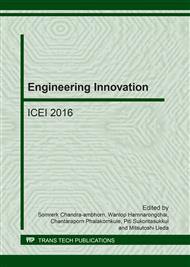[1]
G.W. Vickers, K. W Quan, Ball mills versus end mills for curved surface machining, J. Eng. Ind-T ASME. 11(1989) 22-24.
DOI: 10.1115/1.3188728
Google Scholar
[2]
W.L. RalphIp, M. Loftus, Cusp geometry analysis in free-form surface machining, Int. J. Prod. Res. 30 (1992) 2697-2711.
DOI: 10.1080/00207549208948185
Google Scholar
[3]
H.D. Cho Y.T. Juan, M.Y. Yang, Five axis CNC milling for effective machining of sulptured surface, Int. J. Prod. Res. 31 (1993) 2559-2573.
Google Scholar
[4]
S. Bedi, F. Ismail, M.J. Mahjoob and Y. Chen, Toroidal versus Ball Nose and Flat Bottom-End Mill, Int. J. Adv. Manuf. Tech. 13 (1997) 326-332.
DOI: 10.1007/bf01178252
Google Scholar
[5]
H.Y. Feng, H. Li, Constant scallop-height tool path generation for three-axis sculptured surface machining, Computer-Aided Design. 34 (2002) 647-654.
DOI: 10.1016/s0010-4485(01)00136-1
Google Scholar
[6]
R. Lin, and Y. Koren, Efficient tool-path planning for machining free-form surfaces, J. Eng. Ind-T ASME. 118 (1996) 20-28.
DOI: 10.1115/1.2803642
Google Scholar
[7]
R. Sarma and D. Dutta, The geometry and generation of NC tool path, J. Mech. Design. 119 (1997) 253-258.
Google Scholar
[8]
K. Suresh and D.C.H. Yang, Constant scallop height machining of free-form surfaces, J. Eng. Ind-T. 116 (1994) 253-259.
DOI: 10.1115/1.2901938
Google Scholar
[9]
A. Warkentin, S. Bedi, F. Ismail, Five-axis milling of spherical surfaces, Int. J. Mach. Tool. Manu. 36 (1996) 229-43.
DOI: 10.1016/0890-6955(95)98763-w
Google Scholar
[10]
X.F. Zhang, J. Hie, L. H. Li, Experimental investigation on various tool path strategies influencing surface quality and form accuracy of CNC milled complex freeform surface, Int. J. Mach. Tool. Manu. 59 (2012) 647-654.
DOI: 10.1007/s00170-011-3515-z
Google Scholar
[11]
E. Ozturk, L.T. Tunc, B. Budak, Investigaton of lead and tilt angle effect in 5-axis ball-end milling processes, Int. J. Mach. Tool. Manu. 49 (2009) 1053-1062.
DOI: 10.1016/j.ijmachtools.2009.07.013
Google Scholar
[12]
P. Gilles, G. Cohen, F. Monies, W. Rubio, Torus cutter positioning in five-axis milling using balance of the transversal cutting force, Int. J. Mach. Tool. Manu. 66 (2013) 965–973.
DOI: 10.1007/s00170-012-4381-z
Google Scholar
[13]
F. Jianhua, B. Alan, Quadric method for cutter orientation in five-axis sculptured surface machining, Int. J. Mach. Tool. Manu. 48 (2008) 788–801.
DOI: 10.1016/j.ijmachtools.2007.12.004
Google Scholar
[14]
J. Senatore, S. Segonds, W. Rubio, G. Dessin, Correlation between machining direction, cutter geometry and step over distance in 3-axis milling: Application to milling by zones, Computer-Aided Design. 44 (2012) 1151-1160.
DOI: 10.1016/j.cad.2012.06.008
Google Scholar
[15]
X.C. Wang, Y. Yuan, An approach to interference-free cutter position for five-axis free-form surface side finishing milling, J. Mater. Process. Tech. 123 (2002) 191-196.
DOI: 10.1016/s0924-0136(02)00023-7
Google Scholar
[16]
R. Sarma, D. Dutta, The geometry and generation of NC tool path. J. Mech. Design. 119 (1997) 253-258.
Google Scholar
[17]
G. Kiswanto, H. Hendriko, E. Duc, An analytical method for obtaining cutter-workpiece engagement during a semi-finish in five axis milling, Computer-Aided Design. 55 (2014) 81–93.
DOI: 10.1016/j.cad.2014.05.003
Google Scholar
[18]
G. Kiswanto, H. Hendriko, E. Duc, A hybrid analytical-and discrete-based methodology for determining cutter-workpiece engagement in five-axis milling. Int. J. Adv. Manu. Tech. 80 (2015) 2083-(2096).
DOI: 10.1007/s00170-015-7156-5
Google Scholar
[19]
J.S. Chen, Y.K. Huang, M.S. Chen, A study of the surface scallop generating mechanism in the ball-end milling process, Int. J. Mach. Tool. Manu. 45 (2005) 1077-1084.
DOI: 10.1016/j.ijmachtools.2004.11.019
Google Scholar


